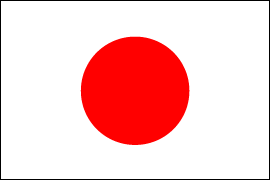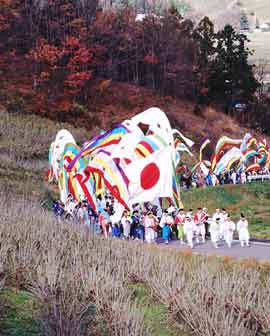|
|||
|
| -Countries |
| -Dictionary |
| -Federations |
| -M.A. Timeline |
| -Number System |
| -Styles |
| -Weapons |
| -Who's Who |
| -Updates |
| -Credits |
| -Stats |
| -Webmaster |
| Japanese Flag
The national flag of Japan is called the Hinomaru. Its name comes from the Japanese word hinomaru, which literally means "sun circle." It is not certain just when the sun-circle symbol was first used on flags and banners. However, in the 12th century samurai warriors (bushi) appeared, and during the struggle for power between the Minamoto and Taira clans, bushi were fond of drawing sun circles on folding fans known as gunsen. In the Warring States period of the 15th and 16th centuries, when various military figures vied for spheres of influence, hinomaru were widely displayed as military insignia. One screen painting depicting the Battle of Sekigahara in 1600 shows a military force whose many banners all share the hinomaru motif. Although a red circle on a white background was the most common, there were also examples of gold circles on a deep blue background.
The Tokugawa shogunate in 1854 accepted a proposal by Shimazu Nariakira of the Satsuma domain, and it was decided that Japanese ships, so as not to be mistaken for foreign vessels, would use a "hinomaru banner with a white background." A hinomaru flag was displayed on the Kanrin maru, the official ship bearing Japanese officials sent to the United States in 1860. In 1868, the Meiji government was established after the Tokugawa family lost political power. According to Proclamation No. 57 issued by the Grand Council of State (Dajokan) on January 27, 1870, the Hinomaru was officially made the flag of Japan for use on commercial vessels. The Hinomaru was first used on the grounds of government buildings in 1872, the year before the lunar calendar was officially replaced by the solar calendar. At that time many ordinary families and non-governmental establishments also expressed the desire to display the Hinomaru on holidays. In subsequent years, a number of notifications and documents were publicly issued which reinforced the Hinomaru's status as the flag symbolizing Japan. |


 The
use of a hinomaru as the symbol of the country as a whole
dates from its use, by Toyotomi Hideyoshi in the late 16th century
and Tokugawa Ieyasu in the early 17th century, on the flags
of trading ships sent abroad. A screen with scenes from the
17th-century city of Edo (present-day Tokyo) shows a hinomaru
flag being used as the symbol of a ship carrying the shogun.
During the period of sakoku, or "national seclusion"
(1639—1854), trade and other relations with all foreign
countries except China, Korea, and Holland were prohibited,
but when the Tokugawa shogunate began to trade with other countries
(including the United States and Russia) after 1854, Japanese
trading ships again began to use a hinomaru flag.
The
use of a hinomaru as the symbol of the country as a whole
dates from its use, by Toyotomi Hideyoshi in the late 16th century
and Tokugawa Ieyasu in the early 17th century, on the flags
of trading ships sent abroad. A screen with scenes from the
17th-century city of Edo (present-day Tokyo) shows a hinomaru
flag being used as the symbol of a ship carrying the shogun.
During the period of sakoku, or "national seclusion"
(1639—1854), trade and other relations with all foreign
countries except China, Korea, and Holland were prohibited,
but when the Tokugawa shogunate began to trade with other countries
(including the United States and Russia) after 1854, Japanese
trading ships again began to use a hinomaru flag.